In Henry’s fingerprint classification system, there are 6 main divisions with 3 common extensions. Primary, major, secondary, sub secondary, final, and key classifications are the six main classifications. While the second-sub secondary, WCDX and special loop division are three extensions.
More precisely, these six divisions with extensions are referred to as FBI modified Henry fingerprint classification system.
The above paragraph is a short introduction to fingerprint classification modified by the FBI.
But, before jumping directly to the six divisions of Henry’s fingerprint classification system modified by the FBI, let’s take a look at the original Henry’s classification system of fingerprints with a simple calculator.
Henry Classification Calculator For Fingerprint
Simply click, and the calculator will do the rest.
To use the calculator, follow the steps:
- Select either one: “Whorl” or “not Whorl”
- Select values for all 10-digit patterns (All need to be filled)
- And you get your number.
- Try Henry Classification Calculator
Forensic Fingerprint Tool: Henry Fingerprint Calculator
-> Check only Whorls or Not Whorls
-> Simple As Click
-> 1024 possible group values
Check Now: Henry Fingerprint System Calculator
Original Henry Classification System
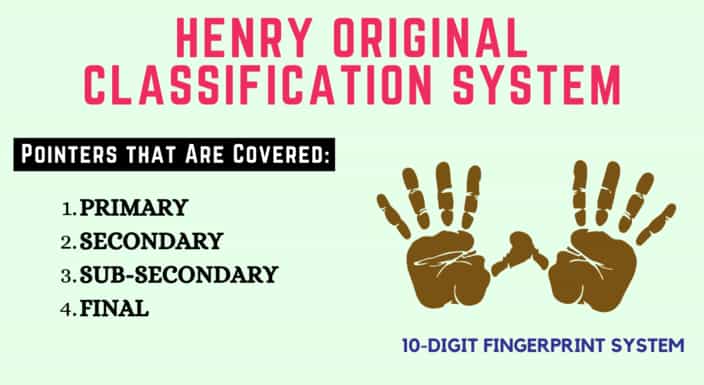
In 1896, Sir Edward Richard Henry developed a fingerprint classification system that uses all fingerprints (hence, also called a 10-digit system).
Prior to the modification by the FBI, the Henry system consisted of 4 classifications system. These were:
- Primary
- Secondary
- Sub-secondary
- Final
With this system, every finger in this world can be registered in one of the 1024 possible groups. In the early 1900s, the system was no longer effective for the effective searching of fingerprints.
But Why Not effective? Why does the original fingerprint division need modification?
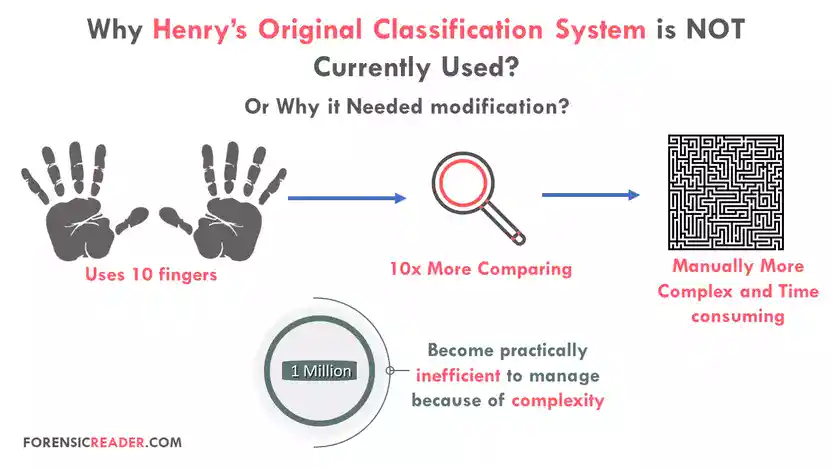
Because, when 1M prints got registered, this classification system by Henry became complex and inefficient to manage.
In the 1920s, the FBI established its fingerprint identification division, which eventually led to the addition of two more divisions to the original Henry system.[1] Similarly, other federal agencies around also came up with their own version of Henry’s fingerprint division.
List of Fingerprint Classification System Originated From Henry
| S.No. | Henry Modified System | Country/ Location |
|---|---|---|
| 1. | Henry Australian System | Australia |
| 2. | American | New York City |
| 3. | RCMP (Royal Canadian Mounted Police) | Canada |
| 4. | Henry FBI Extension | Washington, DC |
| 5. | Windt Kodicek | Germany |
| 6. | Budapest | Budapest, Hungary |
| 7. | Steegers | Cuba |
| 8. | Valladares | Portugal |
| 9. | Pateer | Amsterdam |
| 10. | Spirlet | The Hague |
| 11. | Conlay | Federated Malaysia |
| 12. | Flak Conley | Newark, New Jersey |
Filling a Henry 10-digit Fingerprint Card
In a fingerprint card, there is a specific layout and position of each finger of the hand.
The following is the typical layout of a ten-digit fingerprint card.
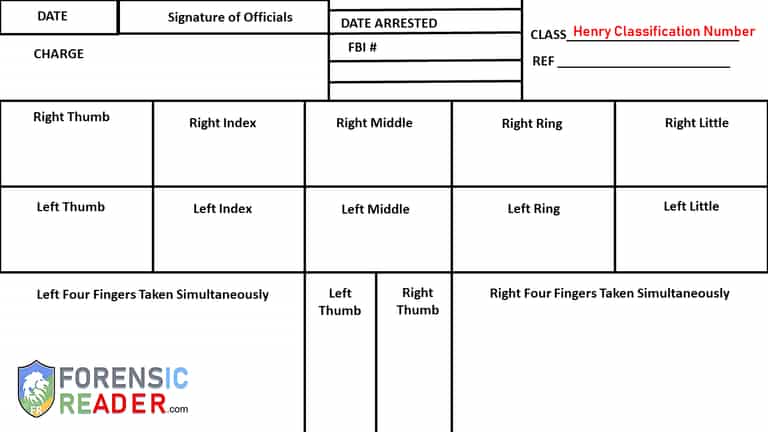
From the above 10-digit fingerprint card, the common interpretation is:
- The right thumb is to be the first finger.
- The left little finger is the 10th.
- Adjacent finger numbers of opposite hands are followed by an addition of 5.
All the fingerprints are patent in their respective position on the fingerprint card. The process of inserting information such as appropriate numbers, letters, and symbols onto the card is known as blocking the card.
You should check our dedicated article on how to fill 10-digit fingerprint cards with rules.
The following is a typical example of the classification of fingerprints using Henry’s System modified by the FBI.

Henry Fingerprint Classification System Modified by FBI
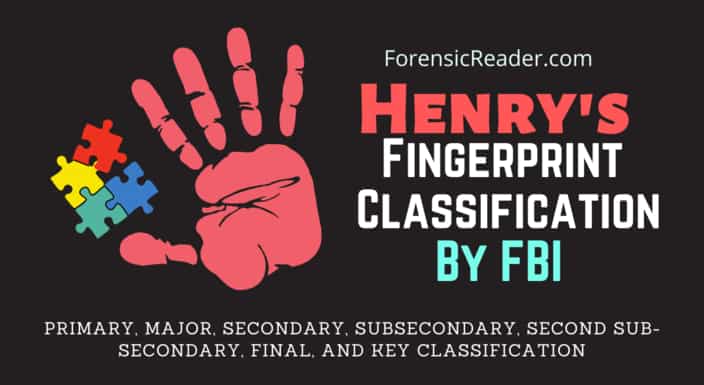
In the FBI-modified version, the classification system consists of 6 main sub-classifications.
- Primary Classification
- Secondary Classification
- Sub-Secondary Classification
- Major Division Classification
- Final Classification
- Key Classification
Main Extension of the Henry Classification System
There are 3 main extensions of the Henry classification system.
- Second sub-secondary classification
- WCDX classification
- Special Loops extension
With the introduction of the AFIS system—an automated one, the 10-digit classification system has come to be known as the manual method of fingerprint classification and identification.
Overview of the Henry Classification System (FBI Modified)
| Sub-divisions | Fingers | Patterns in Consideration | Values |
|---|---|---|---|
| Primary | 10 fingers | Whorls | Specific assigned values |
| Major | Thumb | Loops and Whorls | Ridge count or trace value |
| Secondary | Index finger | All Pattern | Indicated by capital letters |
| Secondary Small Letter | Other than index fingers | Arch, tented arch, or radial loop | Indicated by small letters |
| Sub-Secondary | Index, middle, & ring fingers | Loops and Whorls | Ridge count or trace value |
| Final Classification | Little finger | Loops (rarely whorls) | Ridge count |
| Key Classification | All fingers excluding little fingers | Loops | Ridge count |
| Second SubSecondary* | Index, middle, & ring fingers | Loops | Ridge count |
| WCDX Extension* | All fingers | Whorls | Capital and Small letters |
| Special Loop Extension* | Index, middle, & ring fingers | Loops | Specific values of ridge count |
#1 Primary Classification
The process of manual fingerprint classification always starts with primary classification. In this classification, numerical values of the finger with whorl are considered. If the finger has a whorl, the following value is going to be assigned.
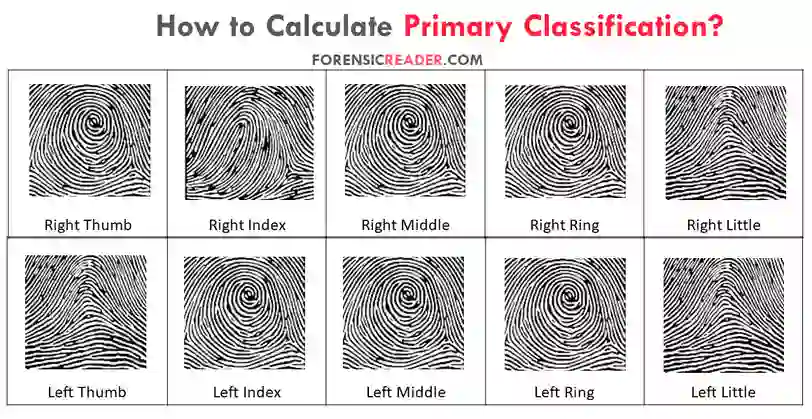
| Rt Thumb (1) 16 | Rt Index (2) 16 | Rt Middle(3) 8 | Rt Ring (4) 8 | Rt Little (5) 4 |
| Lt Thumb (6) 4 | Lt Index (7) 2 | Lt Middle (8) 2 | Lt Ring (9) 1 | Lt Little (10) 1 |
In the case of fingerprints other than whorls such as loops and arches, the value is assigned to be ‘0’.
Article (Note1): Primary Classification of Fingerprints
-> Rules
-> Easy Way to Learn Pair Values [Image]
-> Why ‘1’ is added
-> How Primary Values are arranged in the FBI database
-> Why Other Classifications Also Need
Check Now: Primary Classification of Fingerprint: Rules, Procedure And Worksheet.
#2 Secondary Classification

In secondary classification, the pattern type of the index fingers is designated by a capital letter. In general, the following are the most commonly encountered pattern types:
- A = Plain arch
- T = Tented arch
- R = Radial loop
- U = Ulnar loop
- W = Whorl
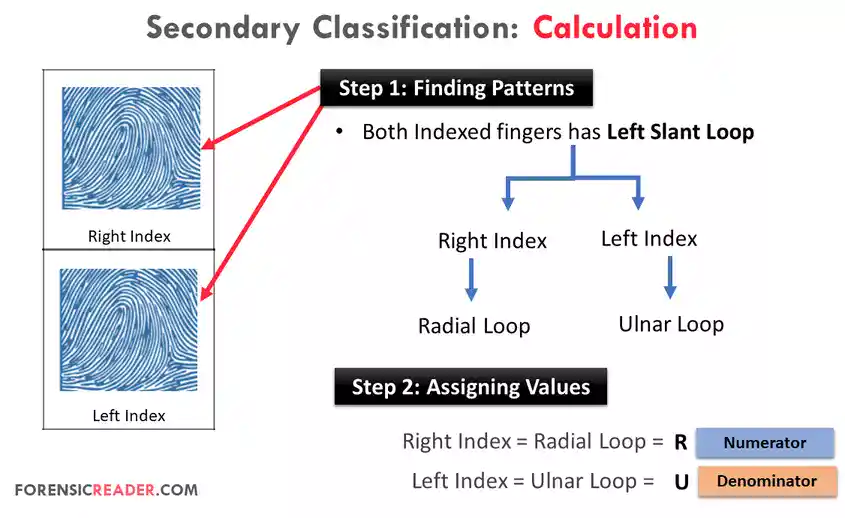
Article (Note 2): Secondary Classification of Fingerprint With Small Letter Group
-> Rules
-> Images
-> Calculation Formula
-> Worksheet
Check Now: Secondary Classification of Fingerprints With Small Letter Grouping with practical examples.
# Secondary Small Letter Grouping
In this classification division, the patterns are indicated by small letters when they appear other than the index finger.
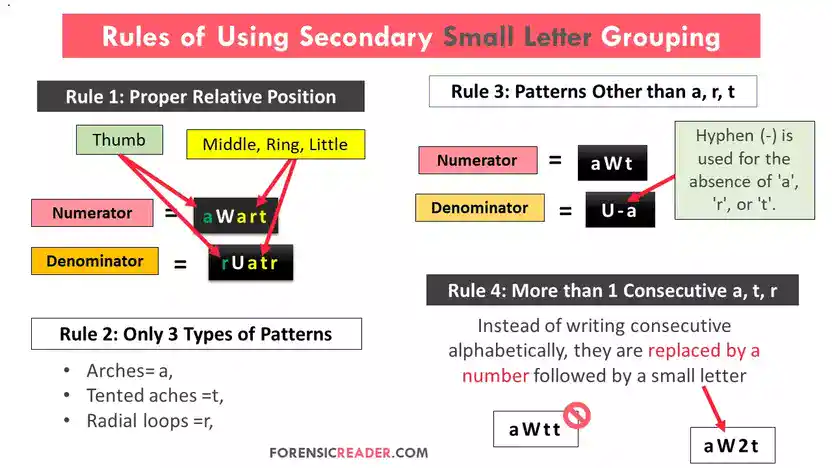
They are given by following pattern type.
- Arches= a,
- Tented arches =t,
- Radial loops =r,
- Ulnar loops (U) and Whorls (W) are indicated by a hyphen (-)
While classification, as stated earlier, these small letters appear next to the secondary capital letters. And they are listed in the order of their occurrence.
Article (Note 3): Small Letter Group in Secondary Division
-> 4 Rules
-> When Small groups are used
-> Calculation Formula
-> Worksheet
Check Now: Secondary Small Letter Grouping With Practical Examples.
#3 SubSecondary Classification
In the sub-secondary classification system,
- ridge counting or tracing performed for loops and whorls, respectively that are
- present on the index, middle, and ring fingers.
Like others, ridge counting values of the right hand are placed in the numerator and the left hand in the denominator.

Article (Note 4): Sub-Secondary Classification of Fingerprint
-> Rules
-> Calculation Formula
-> Worksheet
Check Now: Sub Secondary of Fingerprint With Practical Examples
Also Read:
- Battley Single Digit Classification System: Fingerprint Identification
- How to Fill and Extract Data From Fingerprint Card? Forensic Fingerprinting
- Vacuum Metal Deposition: Principle, Types & Components
#4 Major Division Classification
It was based upon the pattern present in the thumb only. The right thumb value is placed in the numerator followed by the left thumb as the denominator.
In the fingerprint card, the major division’s ridge count or ridge trace values are placed immediately to the left of the primary classification column.
Example of Major Division Classification
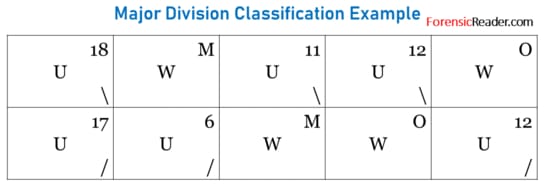
For the above 10-digit card values, the following is the major division value.
| Major | Primary | Secondary | Subsecondary |
| M | 19 | W | MOI |
| L | 6 | U | IMO |
Article (Note 5): Major Classification of Fingerprint
-> Rules
-> Sets of Values
-> Calculation Formula
-> Worksheet
Check Now: Major Division of Fingerprint With Images and Explanation
#5 Final Classification
In this classification, the little fingers of both hands are employed, and ridge counting is performed on loops and whorls patterns.
The right-hand finger counting value is placed in the numerator and the left hand is the denominator. However, only one value is used to classify it in the henry classification line.
The ridge counting of the whorls in the final classification is very rarely used. That’s why the majority of final classification is known to be only loop pattern-driven.
Example of Key Classification System
Let’s take the following example,
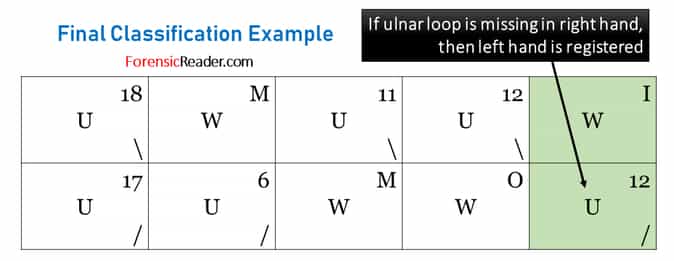
Following is the example of a Henry fingerprint Classification system modified by FBI extension, based on the above example.
| Major | Primary | Secondary | Subsecondary | Final |
| M | 19 | W | MOI | |
| L | 6 | U | IMO | 12 |
Article (Note 6): Final Division of Fingerprint
-> Important Rules
-> When to use
-> Procedure
-> Worksheet
Check Now: Final Classification of Fingerprint With Images
#6 Key Classification System
In the Henry key classification system, you have to count the first loop that appears on the card except for loops on the little finger. In doing so, you just have to place it in the numerator, and place immediately left of the major division value.
Example of Key Classification system
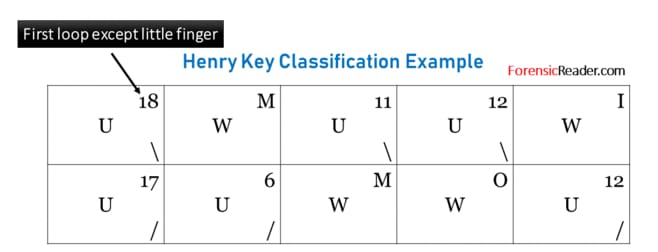
Article (Note 7): Henry Key Classification of Fingerprint
-> Rules to follow
-> Why little finger is excluded?
-> Procedure
-> Worksheet
Check Now: How to Calculate Key Classification of Fingerprint With Images
Extension to Henry Classification By FBI
There are three most common extensions used by the FBI to subdivide large Henry search groups. These are:
- Second sub-secondary classification
- WCDX classification
- Special Loops extension
#1 Second Subsecondary Classification
Second sub-secondary division is an additional classification that is rarely used for classifying the fingerprint in Henry’s classification.
In this sub-division classification system, the patterns present in the index, middle, and ring fingers are considered and symbolized by the specific ridge counting and ridge tracing values.

Article (Note 8): Second Sub Secondary Classification of Fingerprint
-> When to Use
-> How they align on Henry Line
-> Procedure
-> Worksheet
Check Now: Second SubSecondary Classification of Fingerprint
#2 WCDX Classification
WCDX is an acronym for Whorl, Central Pocket, Double, and Accidental Loop Whorls. It is a special extension majorly used to classify the large groups of whorls patterns such as 32/32.
In this classification, only whorls are classified and named down based on the pattern appearing on all of the fingers.

Article (Note 9): WCDX Classification in Henry Fingerprint System
-> When they are used
-> Which Groups are most common
-> Procedure
-> Worksheet
Check Now: WCDX Extension for Classifying Fingerprint
#3 Special Loops Extension
This extension is used to subdivide the primary classification groups where all the fingers have loop patterns.
The value of the special loop extension is brought by ridge count values of the index, middle, and ring fingers (sometimes left little fingers) of both hands. They are assigned specific values for a specific range of loop counts.

Article (Note 9): Special Loop Extension of Fingerprint Classification
-> When to Use
-> How they align on Henry Line
-> Procedure
-> Worksheet
Check Now: Special loop extension of fingerprint With Worksheet
Short Summary of Henry Fingerprint Classification System
The following is the overview (a step-by-step) guide on how you can fill the Henry 10-digit card.
1. Primary Classification: Specific allotted value based on prints of whorl pattern. Values vary from 1/1 to 32/32.
2. Secondary Classification:
- Capital Letters Group: Index finger patterns designated by capital letters.
- Small Letter Group: All fingers other than the index finger. Designated by small letters.
3. Sub Secondary Classification: Ridge count or trace of the index, middle, and ring finger. Designated by specific letter (I, M, O).
4. Major Classification: Ridge counts or trace values of loops and whorls on the thumbs. Designated by letters: for loops (S, L), and for whorls (I, O)
5. Final Classification: Ridge count of loop appearing in the little fingers
6. Key Classification: 1st loop count on the card excluding little finger.
Extesnion to FBI Henry Classification System
References:
- Fingerprints Analysis and Understanding By Hawthorne [Book]
- Advances in Fingerprint Technology by Fisher [Book]
- Fingerprint Analysis Laboratory Workbook by Daluz [Book]
- The Fingerprint: Source Book by NIJ.Gov

This article is made possible because of the efforts of Anuwanshi Sharma. She writes a part of this blog post. You can know more about her form here.
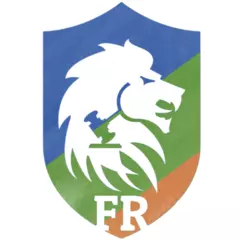
FR Author Group at ForensicReader is a team of Forensic experts and scholars having B.Sc, M.Sc, or Doctorate( Ph.D.) degrees in Forensic Science. We published on topics on fingerprints, questioned documents, forensic medicine, toxicology, physical evidence, and related case studies. Know More.


How do you conduct a manual search if the classification is 1/1 a/a/? [All arches] How is this 10 finger print card filed using the Henry Classification method.?
In the Henry Classification System, there are multiple sub-classifications beyond the primary classification. These include secondary, sub-secondary, final, and key classifications. While the primary classification largely depends on the presence and distribution of whorls, the other classifications also take into account loops and arches. Most of these classifications involve ridge counting and tracing, although these methods are not applicable to arches. Nonetheless, arches and other pattern types are assigned specific values within these classification systems. This detailed categorization results in a more precise and smaller set of groups for each individual. It’s noteworthy that having all ten fingers with arch patterns is extremely rare.
what if all the the fingerprints is ulnar loop? how to calculate it?
the value for the primary classification is 1/1. Secondary classification=U/U, subsecondary= UUU/UUU; and other classification values governed by respective ridge counts.
I WANT TO HAVE A COPY OF THIS
We mailed you the same.